Casting Time: 1 bonus action
Range: Self
Components: V
Duration: Concentration, up to 1 minute
School: 1st-level evocation
Who can cast Thunderous Smite? Only Paladins have Thunderous Smite on their class spell list.
Player’s Handbook, pg. 282
Thunderous Smite 5e
DnD 5e’s Thunderous Smite is a loud, impactful, and perfectly Paladin-esque spell that turns a regular melee attack into a storm of divine fury. We’ll go over a few ways to use this spell to maximum effect, as well as the big rules questions that come up all the time.
How Does Thunderous Smite Work in 5e?
Casting Thunderous Smite causes the caster’s next melee weapon attack that lands to deal an additional 2d6 (7 average) thunder damage and force a Strength saving throw. If the target fails, they’re pushed 10 feet away from the caster and are knocked prone.
The prone condition (PHB 292) has the following effects:
-
Can only crawl (at half movement speed) or stand up (expending half of total moment speed)
-
Disadvantage on attack rolls
-
Attack rolls against it have advantage if the attacker is within 5 feet; disadvantage if <5 feet.
Finally, Thunderous Smite is audible from up to 300 feet away, meaning it’s not usually the best option for stealth missions.
How to Use Thunderous Smite in 5e
Here are a few ways to use Thunderous Smite to get more bang for your buck:
-
Pair with persistent area of effect damage spells. Thunderous Smite is best used in conjunction with spells like Spike Growth, Spirit Guardians, Cloud of Daggers, Moonbeam, etc. While 10 feet isn’t a massive push, you’ll probably be up close as a Paladin anyway. That means you should never be too far to your party’s area of effect spells.
-
Take advantage of hazardous terrain. Beyond spells, the environment itself can provide you with opportunities to make use of a 10-foot push. Cliffs, pits, traps, fires, etc. — there are plenty of things that creatures would much rather not be pushed into — but hey, that’s their problem.
-
Sound an alarm. The 300-foot audible range of Thunderous Smite is often viewed as a downside, but it can also be a strength. Long-distance communication isn’t always feasible, but a loud “bang” from Thunderous Smite can be just the thing to tell your party that danger’s on the way or act as the trigger for your own ambush.
-
Make use of the prone condition. Getting advantage on melee attacks against prone targets is very powerful. Once you have Extra Attack, you can even use Thunderous Smite, knock an enemy prone with attack one, and then run over and get an advantaged attack on your second swing.
Rogues, Barbarians, and really any other melee martial character are going to love you for this as well. Just be sure to consider the initiative count to maximize the number of players that can get in advantaged attacks on the guy before he stands up.
-
Wake up a city. If you need to wake everyone in a 300-foot radius up for some reason, Thunderous Smite is a very quick way to get that done.
What Are the Rules for Thunderous Smite in 5e?
The rules for Thunderous Smite in DnD 5e are as follows:
-
You can use Divine Smite and Thunderous Smite (or any other smite spell) on the same attack. Divine Smite is a Paladin class feature that can be activated after hitting a creature with a melee weapon attack to deal additional damage.
Thunderous Smite (and all other Paladin smite spells) cost one bonus action, must be used before attacking, and last until the first melee weapon attack lands or 1 minute (concentration allowing).
Here’s one Sage Advice thread confirming that Thunderous Smite and Divine Smite can be used on the same attack, and here’s a second Sage Advice thread about Divine Smite and smite spells in general.
-
Thunderous Smite only lasts until the first time a melee weapon attack hits. While Thunderous Smite lasts for up to 1 minute, that just means you essentially have 10 rounds of combat during which to land one melee weapon attack and deal Thunderous Smite’s damage/cause its effect. After that happens, the spell is over.
-
You must cast Thunderous Smite before making the melee attack you want to use it on. So you can’t wait to see if it hits, like with Divine Smite. If you miss your first melee weapon attack, you can always try again on a later round (so long as your concentration is maintained).
-
Being pushed “away from” the caster indicates a straight line directly in the direction the attack. In other words, if you attack someone to the north of you with Thunderous Smite, they are pushed 10 feet north. You can’t choose to push them 10 feet northeast or northwest, unless you adjust your position relative to the target.
-
You need to use a melee weapon for Thunderous Smite to work. So unarmed strikes or natural weapons won’t do. RAW, anyway — most DMs don’t care if you want to toss out a thunderous slap every now and again.
-
Attacks made with a reach melee weapon against a prone creature still suffer from disadvantage if you’re <5 feet from the target. This is a clarification on the prone condition — the rules have to do with distance, not whether the attack is melee or ranged (PHB 292). Here’s Sage Advice confirmation.
If the D&D rules refer to an attack made within 5 feet of a target, it means exactly that: an attack within 5 feet.
If the rules require an attack to be a melee or a ranged attack, the rules say so.
If an attack must be a weapon or a spell attack, the rules say that too. #DnD https://t.co/Hgx5oGoDpW
— Jeremy Crawford (@JeremyECrawford) October 15, 2018
What this means is that polearm and whip users need to be careful about knocking an enemy prone with Thunderous Smite and then following up with an attack from a distance, or else they’ll end up hampering their damage.
A paladin can use Divine Smite on the same weapon attack that benefits from a smite spell like wrathful smite. #DnD https://t.co/0m11gBoKLp
— Jeremy Crawford (@JeremyECrawford) March 15, 2016
Is Thunderous Smite 5e a Good Spell?
Yes, Thunderous Smite is a good spell in DnD 5e. While an average of 7 extra thunder damage isn’t anything crazy, the push effect coupled with the prone condition makes Thunderous Smite very impactful for the entirety of a campaign. In fact, you could even argue that it grows in power as you level, as advantaged attacks become even stronger once characters’ attacks hit harder.
Plus, a bonus action casting time means you’re never really sacrificing much in the way of action economy.
On the downside, the loud sound it produces means that Thunderous Smite is unsuited for stealthy tasks. And Strength is one of the highest average creature ability scores in DnD 5e, so getting the push effect to land is by no means a guarantee.
Thunderous Smite 5e DM Tips
For DMs, there’s one major thing to consider with Thunderous Smite or its loud cousin, Thunderwave: How much of a hassle do you want to make for players that cast these spells in busy dungeons?
For reference, most battle maps are smaller than a 300-foot radius. That means if you drew a dungeon with multiple monsters in many rooms, they should all hear it when Thunderous Smite is cast.
Now, that doesn’t mean that every monster will rush directly to the source of the sound. But if you’re DMing a well-defended keep with professional soldiers who are on the lookout for attack — well, they’ll probably make the players pay for using such a noisy spell.
Other than that, don’t feel like you need to punish players every time they cast a loud spell; only when they fail to take into account narrative conditions that you’ve made clear.
DnD 5e Thunderous Smite FAQ
Thunderous Smite DnD 5e FAQ:
-
Does Thunderous Smite deal extra damage on a critical hit? Yes, Thunderous Smite does grant additional damage on a critical hit. You roll its damage twice, as you do with all damage dice involved in the attack roll.
-
Why is Thunderous Smite concentration? Thunderous Smite requires concentration because its effects can last for up to 1 minute or until an attack with the enchanted weapon hits a target, requiring the caster’s sustained focus.
-
Can you Divine Smite and Thunderous Smite? Yes, you can combine Divine Smite with Thunderous Smite. The order matters: use Thunderous Smite before attacking, and if the attack hits, you can follow it up with Divine Smite.
Simple Thunderous Smite 5e Spell Text
Thunderous Smite: (1st-level evocation, 1 bonus action, Self, Concentration, up to 1 minute, V) Your next melee weapon attack that hits deals an additional 2d6 thunder damage. Target must succeed on a Strength saving throw or be pushed 10 feet away from you and knocked prone. Audible within 300 feet.


![Searing Smite 5e [DnD Spell Guide: Uses, Rules, Tips] dnd-blue-dragon-vs-party-minis](https://www.dndlounge.com/wp-content/uploads/2022/03/dnd-blue-dragon-vs-party-minis-300x203.jpg)
![Fly 5e [DnD Spell Guide, Tips, Rules, Uses] misty-step-5e](https://www.dndlounge.com/wp-content/uploads/2022/03/misty-step-5e-300x161.jpg)
![Barkskin 5e [DnD Spell Guide: Uses, Rules, Tips] dungeons-and-dragons-party-vs-troll-minis](https://www.dndlounge.com/wp-content/uploads/2022/03/dungeons-and-dragons-party-vs-troll-minis-300x200.jpg)
![Frostbite 5e [DnD Spell Guide: Uses, Rules, Tips] dnd-5e-ice-dragon-and-dice](https://www.dndlounge.com/wp-content/uploads/2022/03/dnd-5e-ice-dragon-and-dice-300x157.jpg)